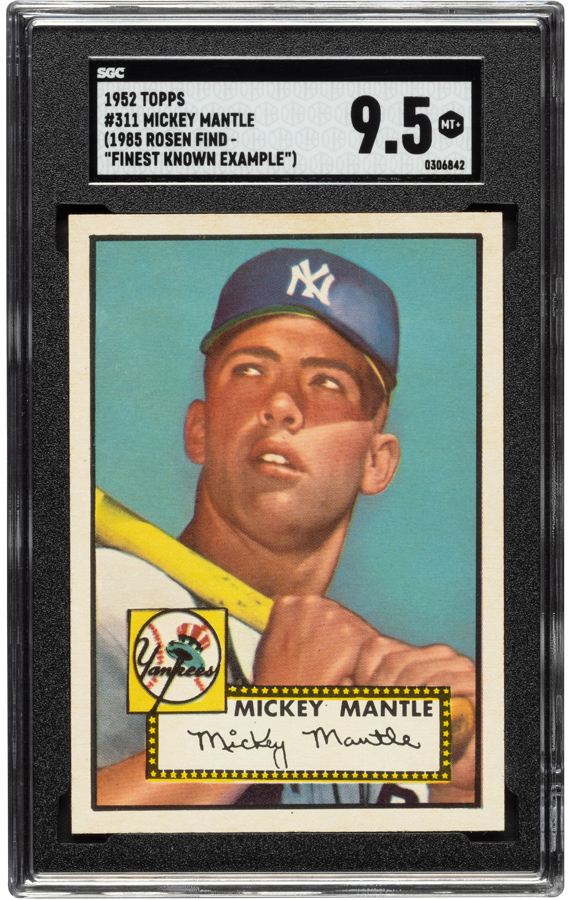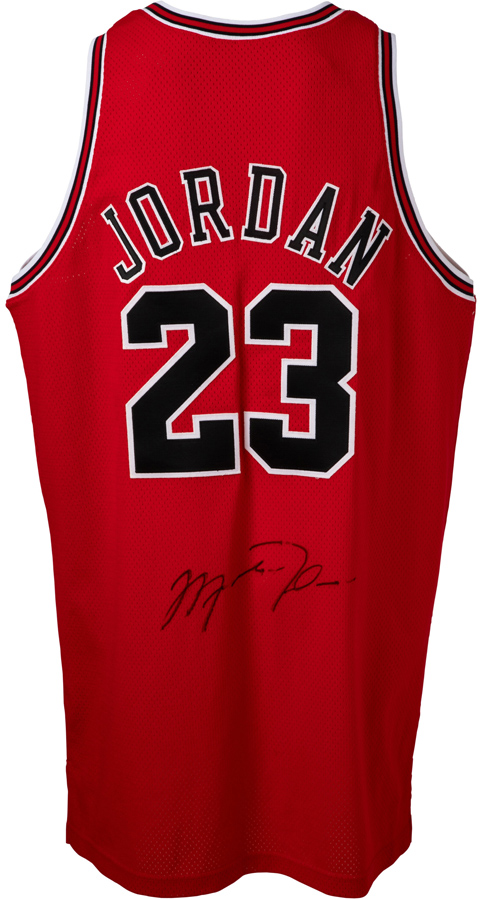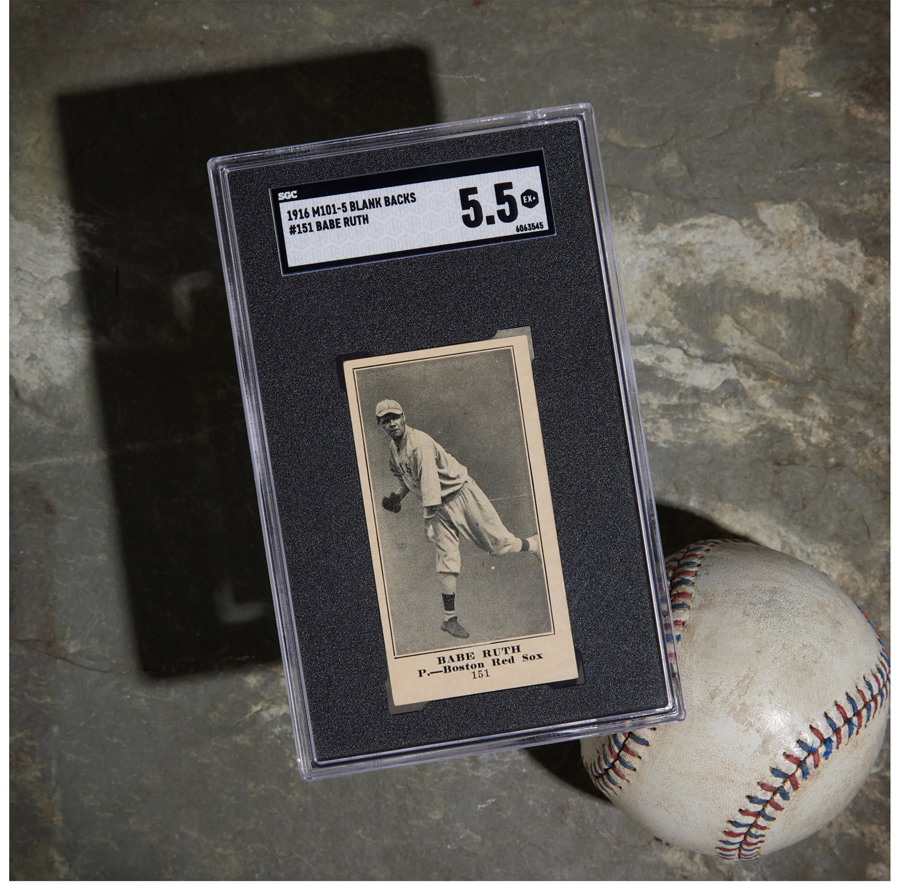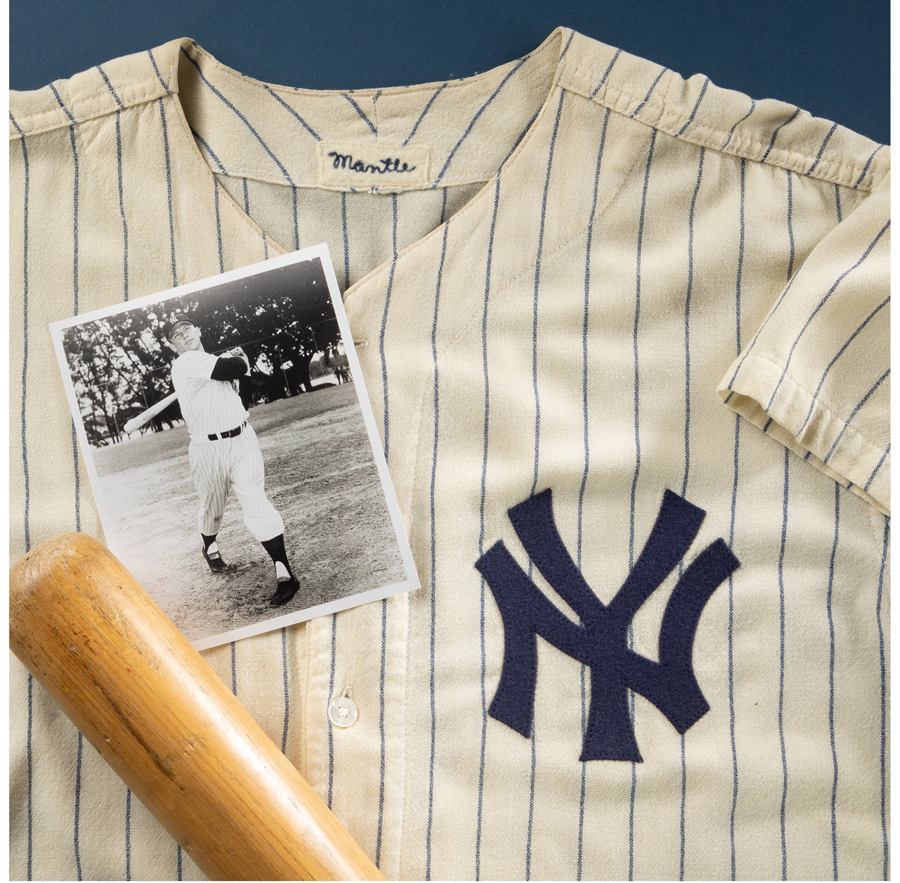HERITAGE AUCTIONS’ HEAD OF SPORTS ON LEADING A RECORD-BREAKING TEAM, THE THRIVING MEMORABILIA MARKET AND THE SURE-FIRE WAY TO WIN AT COLLECTING
Interview by Rhonda Reinhart • Portraits by Josh David Jordan
In 1985, when he was 9 years old, Chris Ivy bought his first pack of baseball cards at a convenience store. From then on, the hobby had him in its clutches, and he was soon spending almost every weekend trading cards with his friends, haunting card shops in his hometown of Dallas and scoping out the few card tables at the coin shows he would attend with his father.
Nearly 40 years later, Ivy is still hooked – and that hobby has turned into a career.
Chris Ivy, Director of Sports Auctions at Heritage
After studying to be a professional grader with Sportscard Guaranty Corporation (SGC), Ivy joined Heritage in 2000 and three years later founded Heritage Sports, a division that recorded nearly $180 million in total sales in 2022. But when he isn’t helping clients amass some of the most significant private collections in the hobby or working with consignors to bring their assemblages to auction, Ivy stays focused on building and improving his collection of signed Hall of Fame rookie cards from the 1980s, as well as unearthing unique Michael Jordan material.
“Staying engaged with collecting helps me to keep my finger on the pulse of the market,” he says, “and there is nothing like the thrill of the chase for a collector!”
Below, Ivy talks summer auction highlights, world record sales and what he loves most about his work.
In 2003, you were the driving force behind the launch of Heritage’s Sports division. Twenty years later, Heritage Sports is the largest vintage sports auction house in the world. What’s the secret to your success?
I think the secret to our consistent growth in this competitive business has been threefold. First, a focus on slow and steady growth by doing it right and keeping quality and customer service at the top of our priority list. Second, we have always sought to bring the best experts in the industry to our team, including professional card graders and executives from other facets of this industry and others. That expertise and professionalism has been instrumental in not only the growth of Heritage Sports, but also for the industry as a whole. Third, I think Heritage’s marketing and cross-marketing abilities among our 50-plus collectible categories have helped to expose our consignors’ material to the widest possible audience of qualified bidders, helping us to consistently achieve world record results.
When this 1952 Topps Mickey Mantle rookie card sold for $12.6 million in Heritage’s 2022 Summer Platinum Night event, it became the most valuable sports collectible ever sold at auction.
Last year was a record-breaking year for Heritage Sports in more ways than one. In addition to the highest price ever paid at auction for a game-used bat ($1.68 million for a signed Babe Ruth bat from 1918 to 1922) and the highest price ever paid at auction for a Mickey Mantle jersey ($2.19 million for the 1968 jersey Mantle wore when he played his final game as a New York Yankee), Heritage sold a 1952 Topps Mantle rookie card for $12.6 million, the highest price ever realized at auction for any sports collectible. What was that day like for you?
Well, to be honest, that day was stressful, as are most of the closing dates for our large catalog and Platinum Night auctions. What many people do not realize is that garnering this incredible material on consignment is only half the battle. Those world record prices are not a matter of chance, but the culmination of weeks of hard work by our incredible staff to authenticate, image, describe and promote this material to the best of our ability with a focus on accuracy for our bidders. Then, once the auction begins, we work the material by speaking with collectors and investors from around the globe to make sure these items perform to the best of their ability at auction.
Why do you think there has been such growth in the sports memorabilia market?
This is a question I have answered many times in the last few years, but it is a great question, and there are several reasons for the incredible growth that the sports collectibles industry has experienced over the last several years. First and foremost, this is a fun hobby filled with very cool material that tells a wonderful history of our nation via sports. I have always felt that this unique material was undervalued, so it is great to see so many new collectors jumping into the hobby. As far as the “why” is concerned, I think a huge portion of the growth is due to economic timing. As the government printed money to combat the economic effects of the COVID-19 pandemic, that money was cheap for investors, and it was clear that inflation was going to creep up. One of the primary ways to combat inflation is to purchase hard assets and alternative assets, especially if investors feel that more traditional investment opportunities have already been maximized. Sports collectibles, and all collectibles, represent tangible assets that have historically grown in value at a rate higher than inflation. I believe the third significant reason for the growth we have seen is the age of the collectors. Many of the collectors and investors we are seeing jumping back into the market were kids in the 1980s during the first big sports collectibles boom, and now they can afford much of the material that they could not as youngsters.
Under Ivy’s management, Heritage Sports recorded nearly $180 million in total sales last year.
The record-breaking moments mentioned above were obviously special occasions, but what’s a typical workday like for you?
I primarily focus on managing our team as we are always striving to make the next deadline. I deal with media and mainstream promotion of our auctions as well as any issues that may arise. In addition, I continue to enjoy working with both new and old clients to be of assistance with building their collections or advising them on how to maximize their financial return at auction.
Is there one part of the job you love the most?
Absolutely. I am still a collector at heart, as is most of the Heritage team, so it is still great fun when an exciting new piece comes into the office. We get to work with incredible collectibles as we find them new owners via auction. One of the greatest perks of this job is visiting collectors in their homes and offices to share their passion for their collections and how they choose to display them.
This 1998 Michael Jordan ‘Last Dance’ game-worn, signed and photo-matched Chicago Bulls jersey being offered in Heritage’s August 19-20 Summer Platinum Night Sports Auction is an auction highlight for Ivy, a longtime Jordan fan.
Heritage’s Summer Platinum Night Sports Auction is coming up August 19-20. What are some of the highlights you’re most excited about?
Our 2023 Summer Platinum Night auction is shaping up to be one for the ages, with incredible material included from all sports, genres and categories. I suspect it will come close or may even surpass our $39.5 million 2022 Summer Platinum Night auction, and that is without the record-setting $12.6 million 1952 Mickey Mantle card. Speaking of Mantle, this Platinum Night will feature an all-original and photo-matched 1958 Mickey Mantle Yankees home jersey, as well as an incredible SGC Mint 9 1952 Topps Mantle card, both of which we expect to sell for well into seven figures. With that said, there will be material for all types of collectors, including a high-grade Babe Ruth rookie card, a photo-matched 1998 Michael Jordan playoffs jersey and the most complete signed Sports Illustrated collection ever offered, spanning the entire history of the magazine with over 2,000 original autographs. And that’s just to name a few.
In any given auction, you can’t always predict which lots bidders will respond to, but is there one category in particular right now that is seeing increasingly impressive results? If so, why do you think that is?
The sports collectibles market has seen incredible growth over the past few years, and that growth has been across all sectors, with a focus on both vintage and modern cards, as well as specific athletes who would be considered the greatest to ever play the sport, such as Babe Ruth, Wayne Gretzky, Michael Jordan, Muhammad Ali, Mickey Mantle, Pelé, Tom Brady and a handful of others. The explosive growth in cards was largely due to new collectors entering the market as graded cards are commoditized and easier to understand for a new collector and/or investor. However, as those collectors become more sophisticated in their collecting, they begin to branch out into other categories, and many collectors both new and old felt that a Mantle rookie card selling for over $1 million while one of his handful of early game-used bats was selling below that level was a bit out of balance. So that is a long way of saying that unique top-notch game-used and game-worn memorabilia is continuing to rise in value and see world record auction results across the board as collectors realize how scarce it truly is.
Other Ivy favorites in Heritage’s August 19-20 Summer Platinum Night Sports Auction include this photo-matched 1958 Mickey Mantle game-worn New York Yankees jersey and a blank-back version of Babe Ruth’s 1916 rookie card.
On that note, do you have any advice for emerging sports memorabilia collectors?
I would suggest that collectors read books, articles and auction archives to educate themselves as much as they can about what they are interested in collecting. I would also recommend that they engage with experts and work with trusted dealers and auction house experts who stand behind the material they offer for sale. Last, and most important, is to simply collect what you love. In addition, it’s certainly not too late to focus on new or emerging genres of sports collecting. Twenty-five years ago, there were only a few dozen game-used bat collectors out there, and now that portion of the business accounts for many millions in annual transactions. The same can be said for photography collecting only 15 years ago, so there are still aspects of this hobby that remain to be explored. Historic tickets are one of the most recent genres of collecting that have seen incredible growth. In the long run, if you collect what you love and the hobby brings you joy, then you are winning.
 RHONDA REINHART is editor of Intelligent Collector.
RHONDA REINHART is editor of Intelligent Collector.







